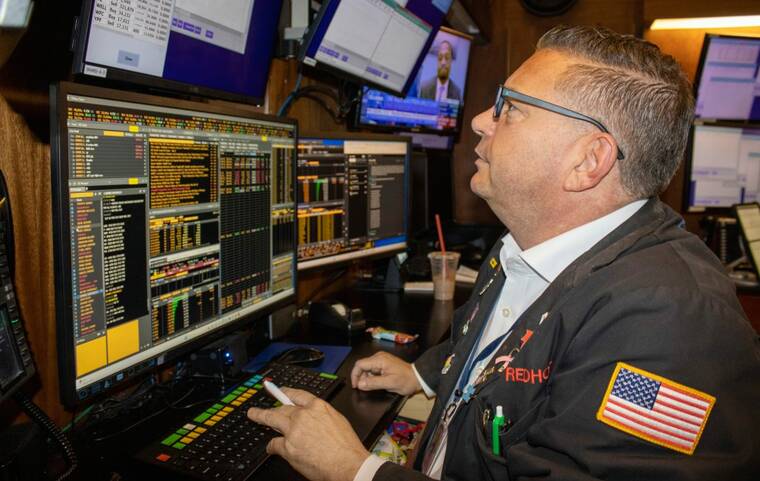Wall Street leaps after nuanced jobs report

ASSOCIATED PRESS
Traders work on the New York Stock Exchange floor in New York City, Sept. 5. Wall Street is climbing in a whipsaw today after looking deeper into the nuances of a surprisingly strong report on the U.S. job market.
NEW YORK >> Wall Street rallied in a whipsaw today and erased its morning losses after looking deeper into the nuances of a surprisingly strong report on the U.S. job market.
The S&P 500 climbed 1.2% after charging back from an earlier drop of 0.9%. The Dow Jones Industrial Average rose 288 points, or 0.9%, and the Nasdaq composite flipped to a gain of 1.6%.
Stocks initially tumbled after a report showed U.S. employers added nearly twice as many jobs last month as economists expected. The strength raised worries that a too-hot job market could keep upward pressure on inflation, which in turn could push the Federal Reserve to keep interest rates higher than investors want.
Treasury yields leaped following the release of the report, and the yield on the 10-year Treasury again soared to its highest level since 2007. It was at 4.78%, up from 4.72% late Thursday.
Wall Street hates high interest rates because they knock down prices for all kinds of investments. And even though the job market hasn’t faltered yet, despite the Fed pulling its main interest rate to the highest level since 2001, high rates work to extinguish high inflation by slowing the entire economy. That raises the risk of a recession down the road.
But Treasury yields pared their gains as the morning progressed, particularly shorter-term ones, as economists pointed to some more encouraging data within the jobs report.
Don't miss out on what's happening!
Stay in touch with breaking news, as it happens, conveniently in your email inbox. It's FREE!
The two-year Treasury yield more closely tracks expectations for action by the Fed, and it quickly soared from 5.04% just before the release of the jobs report to 5.20% shortly afterward. It then pulled back to 5.08%.
Among the potentially encouraging signals for the Fed: Workers’ average wages rose at a slower rate in September than economists expected. While that’s discouraging for workers trying to keep up with inflation, it could remove some inclination by companies to keep raising prices for their products.
The Fed should be focusing on such moderate wage gains, rather than the growth in jobs, said Brian Jacobsen, chief economist at Annex Wealth Management.
“The labor market isn’t overheating, it’s still healing,” he said.
Average hourly earnings rose at the slowest rate, on a year-over-year basis, since June 2021.
“Like most reports, Fed will find things to like and dislike here,” according to Andrew Patterson, senior economist at Vanguard.
That raises the stakes for upcoming reports next week on inflation at both the consumer and wholesale levels. They’re the next big data points due before the Fed makes its next announcement on interest rates on Nov. 1.
Some economists said the Fed may also not need to do as much with its overnight interest rate after financial markets have already done some of its work for it. The 10-year Treasury is the centerpiece of the bond market, and it’s already leaped sharply from less than 3.50% during the summer and from just 0.50% early in the pandemic.
The higher 10-year yield raises rates for mortgages and all kinds of other loans, which can put the brakes on the economy and inflation.
A strong job market also carries some rewards for financial markets in the short term. It means the economy is still doing well despite high rates, which could support corporate profits.
The day’s whiplash for stocks meant the S&P 500 went from a loss of 0.9% to a gain of as much as 1.5% That swing of 2.4 percentage points was the S&P 500’s largest since March, when high interest rates triggered a crisis in the banking industry that sent financial markets around the world into turmoil.
Wall Street’s swings for the day were encapsulated by Levi Strauss, which went from an early loss of 6% to a gain of 1% and back to a loss of 0.8%.
The company reported slightly stronger profit for the latest quarter than analysts expected. But its revenue fell short of expectations, and it said it expects earnings for its full fiscal year to fall at the low end of its forecasted range.
Next week will see the unofficial start to earnings reporting season for the S&P 500, with Delta Air Lines, JPMorgan Chase and UnitedHealth Group among the big companies scheduled on the calendar.
General Motors rose 1.9% after the United Auto Workers union said it will not expand its strikes against Detroit’s three automakers. The union said GM made a breakthrough concession on unionizing electric vehicle battery plants.
All told, the S&P 500 rose 50.31 points to 4,308.50. The Dow gained 288.01 to 33,407.58, and the Nasdaq jumped 211.51 to 13,431.34.
Oil prices also swung several times through the day, continuing a choppy stretch. A barrel of benchmark U.S. crude rose 48 cents to settle at $82.79, while Brent crude, the international standard, rose 51 cents to $84.58.
U.S. crude has been generally pulling back since topping $93 per barrel last week. That’s offered some relief on the inflation front after crude had been charging higher from $70 in the summer.
In stock markets abroad, indexes were higher across much of Europe and Asia. Japan’s Nikkei 225 was an outlier and slipped 0.3%.



